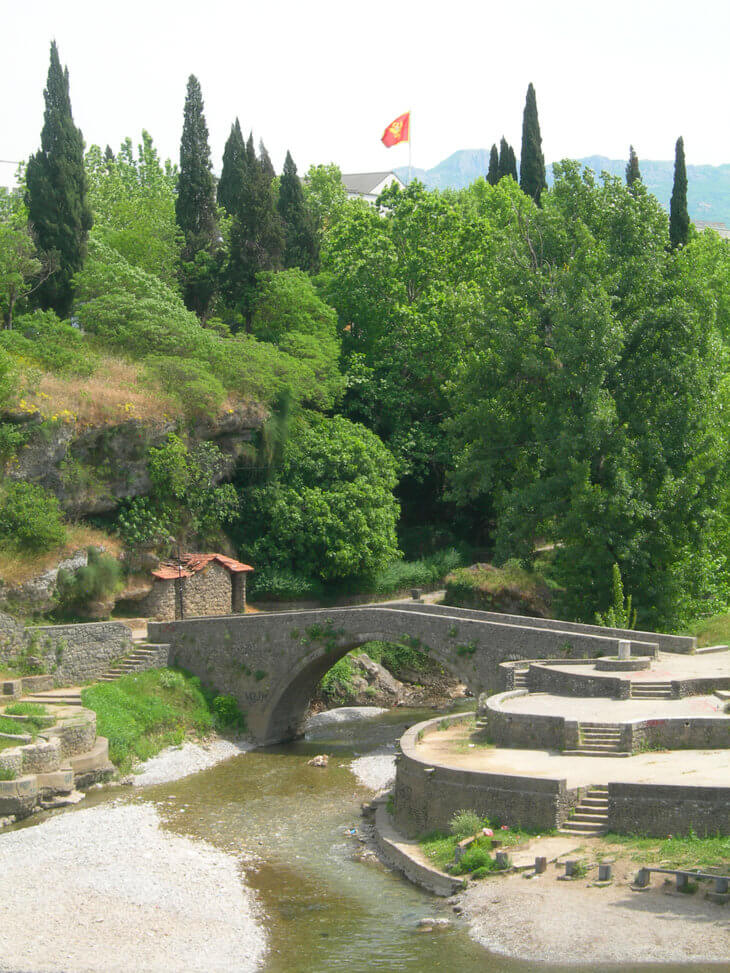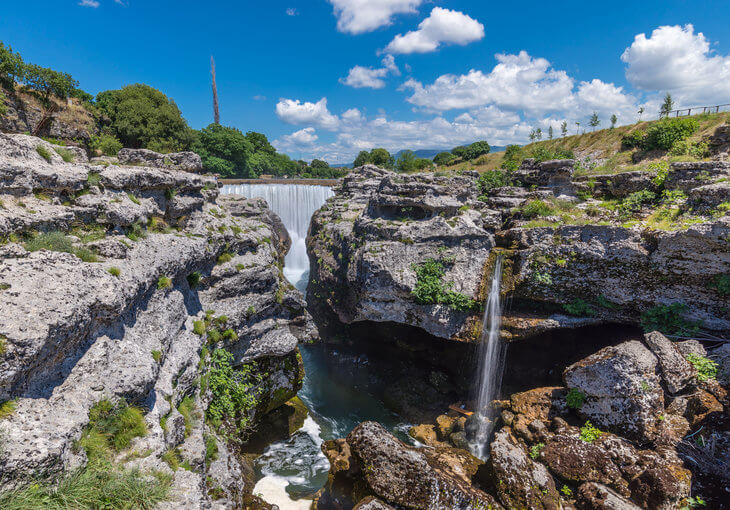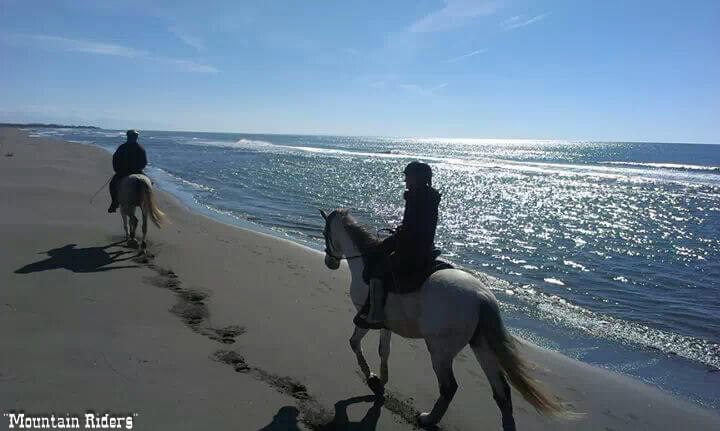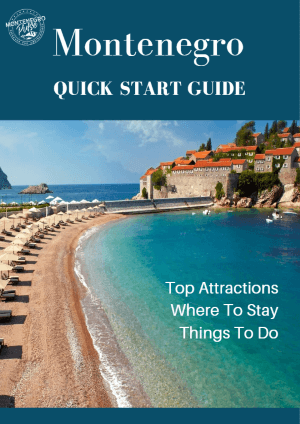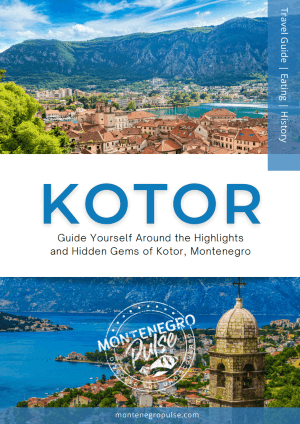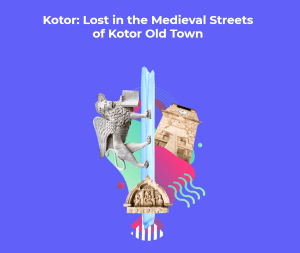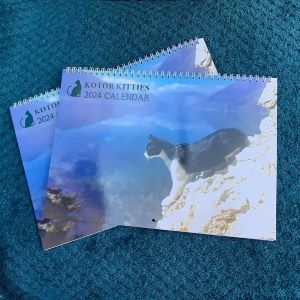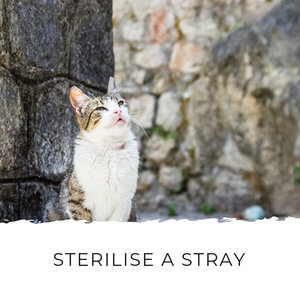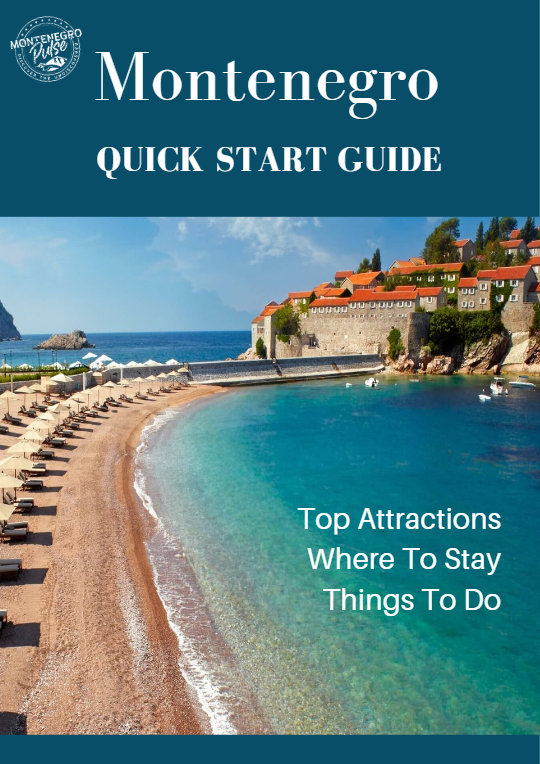Montenegro Pulse contains affiliate links and is a member of the Amazon Services LLC Associates Program. If you make a purchase using one of these links, I may receive compensation at no extra cost to you. See my disclaimer for more information.
Guide to Visiting Ostrog Monastery in Montenegro
Built into a sheer cliff, Ostrog Monastery is one of the most beautiful and revered holy sites in Montenegro.
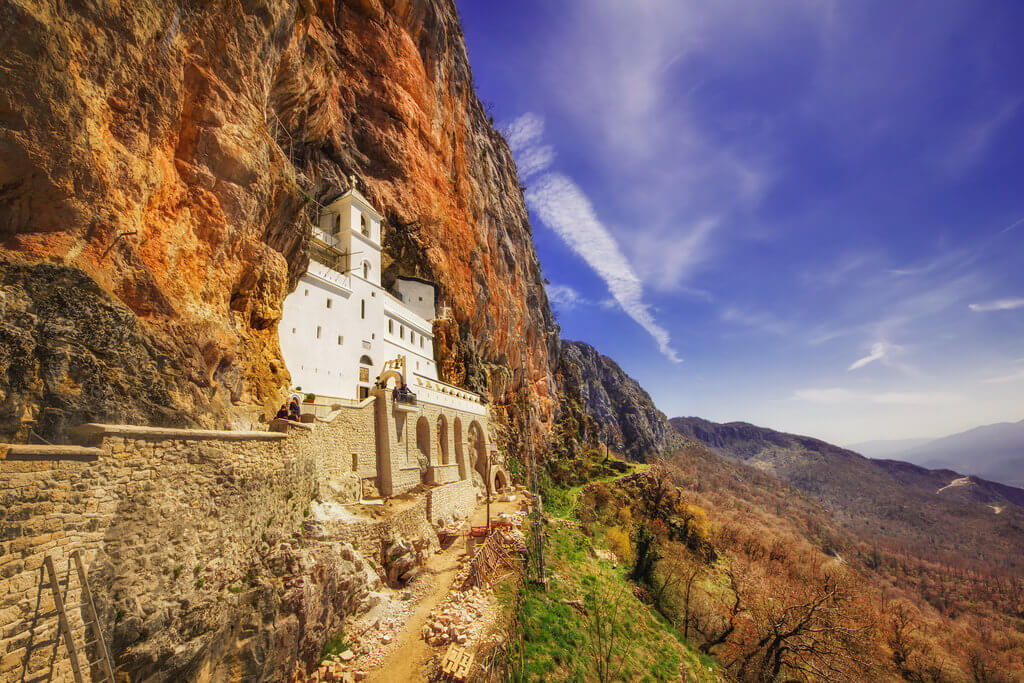 Ostrog Monastery. Image: Deposit Photos
Ostrog Monastery. Image: Deposit PhotosOstrog Monastery is one of the most revered religious sites in all of the former Yugoslav states. It’s visited by up to a million tourists and pilgrims every year. It’s also revered and visited by Orthodox Christians, Roman Catholics and Muslims.
We took a trip up here in June and it was the perfect weather to see this marvel of human dedication and engineering. The sun was shining, the flowers were blooming and we enjoyed the mountain air.
From afar, Ostrog looks like it defies gravity. It’s built right into a sheer cliff face way above the plains below. You can see the white of the building shining like a beacon against the dark rock from miles away.
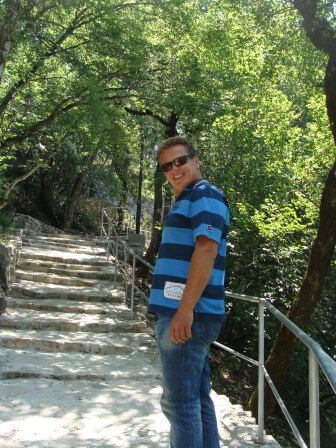 The walk to the upper monastery
The walk to the upper monasteryThere are two parts to the monastery: the upper and lower monasteries. We parked at the lower monastery and followed a lovely path through the woods for about 45 minutes to the upper monastery. If it’s hot or you’re not up for the hike, you can park further up, but there’s still a 10 minute walk to the top. If you have elderly or disabled people with you who can’t walk the last part, you can drive to the upper monastery (the part in the cliff that is the main attraction).
Although Ostrog Monastery is a tourist attraction, it’s very much a place of worship and has a sombre air. The hushed tone of the place is perfect for allowing you to appreciate the views over the plains and the dedication it must have taken to construct this church in the side of a cliff.
The Foundation of Ostrog Monastery
Ostrog Monastery was founded by St Basil, or Vasilije as he’s known here (28.12.1610 – 29.04.1671), the Metropolitan Bishop of Herzegovina, who was later to become St Basil of Ostrog Monastery.
The Life of St Basil
St Basil was born 28th December 1610 in Herzegovina which was then part of the muslim Turkish Ottoman Empire. He was born Stojan Petrovic Stojanovic Jovanovic to parents Petar and Ana. Fearing for his safety, his parents entrusted him to his uncle Seraphim in Zavala Monastery.
Later, his uncle sent him to a monastery in Trebinje (now Bosnia and Herzegovina) to further his studies. He lived an ascetic life and years later, he reluctantly accepted the position of Bishop of Zahumlje and Skenderija. He lived at Tvrdosh Monastery, but when the Turks attacked and destroyed it, he moved to Ostrog in Montenegro.
Building the Monastery
St Basil started with three caves in the rock face. He decided to build the Church of the Presentation in the first cave, a bedroom for guests in the second cave and a chapel which would house religious artefacts in the third cave.
There was already a church below the monastery so he also added a house for monks and wheat milling here.
The Glorification of St Basil
St Basil continued expanding the monastery throughout his life until he died there in 1671 at the age of 61. In 1678, seven years after his death, the abbot of St Luke Monastery nearby had a dream about St Basil. In it, he ordered him to go to Ostrog and open his grave. Initially the abbot ignored the dream, but it plagued him and after dreaming the dream for the third time, he told the monastery about it and went to Ostrog.
When they got there, they fasted and prayed for seven days. On the seventh day, they opened the grave.
St Basil’s body was perfectly preserved and smelled of basil. So they took it to the upper monastery, to the Church of the Presentation, which is where it still lies to this day.
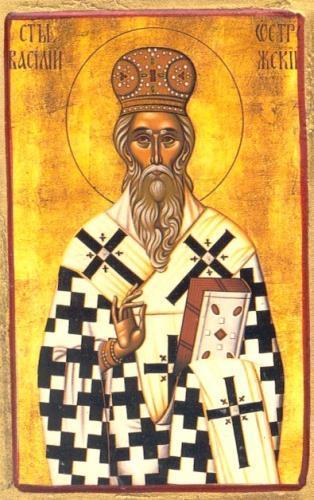 St Basil of Ostrog icon
St Basil of Ostrog iconHistorical Events at the Monastery
The site of Ostrog and St Basil’s relics have had to be defended many times in the last 300 years.
In 1714, the monks buried the relics below the monastery, near the Zeta river to protect them from Turkish Numan-Pasha Chuprilic. The river flooded but luckily the relics were spared.
In 1852 the relics had to be moved a gain. The Turkish commander Omar Pasha attacked the monastery and the siege lasted nine days. The monastery was defended by just 30 Montenegrins, led by Duke Mirko Petrovic. After they successfully defended the monastery, they moved the relics to Cetinje where they stayed in the Church of the Nativity of the Holy Virgin until the spring of 1853.
They were taken back to Cetinje for a year from 1877 to 1878. Finally, the relics were moved to a small cave behind the monastery during the Second World War, but the monastery was never damaged by German bombs.
What to See
The Lower Monastery
The lower monastery centres around the Church of the Holy Trinity, built in 1824.
This is also where most of the monastic residences are and the konak, where pilgrims can find a bunk for the night.
You can park here and walk up to the upper monastery, or you can continue further and park in the parking lot closer to the upper monastery.
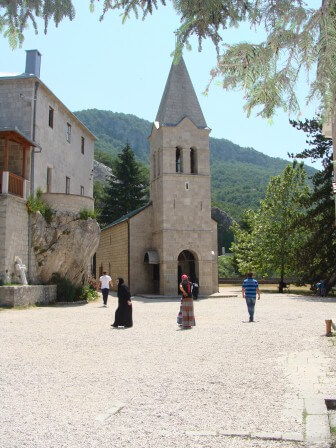 The lower monastery
The lower monasteryThe Upper monastery
The upper monastery is a 3km / 2 mile walk uphill from the lower monastery.
A fire destroyed much of the monastery and it was renovated between 1923 and 1926. Two churches in the caves survived and they’re now the main areas of the monastery.
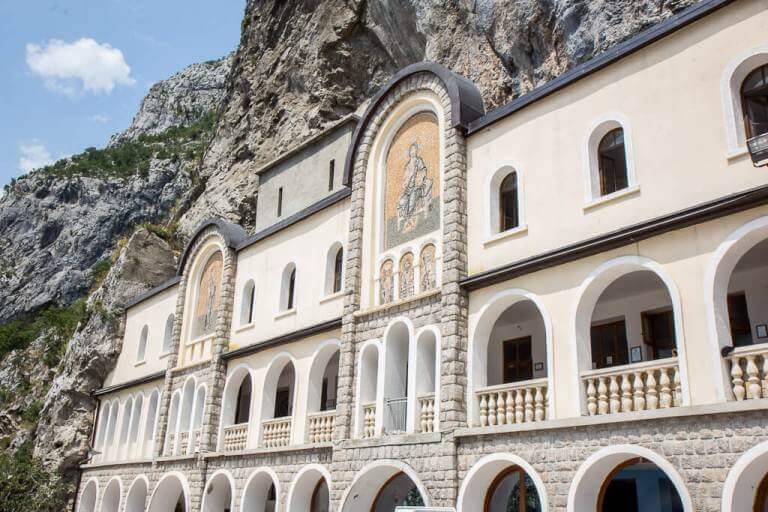 The upper monastery
The upper monasteryThe Church of the Presentation
The frescoes here were painted at the end of the 17th Century. This is where St Basil’s relics are. You can visit and offer a prayer to his relics. There’s often a queue to enter, particularly in summer and on weekends, but the monks of the monastery usher people in and out very quickly so it doesn’t take long.
You’ll be ushered into a very small room where the relics are watched over by a monk. You can pass by the relics and kiss the cross if you wish, then you’ll be ushered back out again. It’s common here to see people out of the room backwards, but you don’t need to feel obliged to do this. It’s a new practice and is considered by many locals to be unnecessary.
Local's Tip: It’s traditional to bring offerings of food, blankets, clothing or soap that you leave for the monks before you enter the church.
The Church of the Holy Cross
This church is in a cave on the upper floor of the monastery and the frescoes were painted by the Serbian master artist Radul. They’re in very good condition considering the location and the damp inside. The most impressive thing about these frescoes is that they had to be painted around the natural contours of the rock. They depict St Sava, St Basil naturally, scenes from the life of Christ and religious holidays.
This church was named the Church of the Holy Cross because it’s believed that a piece of the cross Christ was crucified on was given to the church when it was built.
The Miracle Vine
When you head up to the top floor of the upper monastery, you’ll come out on a balcony that overlooks the plains below. The view is stunning and makes you wonder how on earth they managed to build a monastery here – in the 17th Century no less. In a corner of the balcony you’ll see a vine coming out of the cliff. Locals say it’s a miracle it grows here, out of the cliff, where no vine should rightly be able to grow.
The Church of St George
The ruins Church of St George lies about 200m above the lower monastery. The church was burned by invading Turkish armies in 1770 and wasn’t rebuilt. You can still see the outline of the building and there’s a small cemetery beside it.
Customs and Traditions
Walking Barefoot
Don’t be surprised if you see people walking from the lower monastery to the upper barefoot or on their knees – this is also a common tradition.
Souvenirs and blessed tokens
It’s traditional to buy tokens at the monastery and touch
friends and family who need a miracle with them so that they’re blessed by St
Basil.
Leaving prayers
Pilgrims to Ostrog can write prayers for St Basil and the
priests of the monastery will read them aloud during liturgy.
Lighting candles
Lighting candles for the living and the dead is a practice you’ll find at all Serb Orthodox churches. Usually there’s a metal stand at the front of the church where you kiss, then light, then place your candles. In Ostrog, there are places on either side of the room – one side for the living, one side for the dead.
Holy Water
It’s also tradition to take some local holy water home with you. There’s a tap on the left when you enter the upper monastery where you can fill your bottle fresh, cold mountain water. This is also particularly welcome on a warm day after you’ve hiked up all the steps to get there!
Dress Code
You need to wear or bring a long skirt, trousers or jeans to
enter the monastery. There’s nowhere to change so bring a towel and be prepared
to get changed in your car if it’s too hot to wear these all day. You’ll also
need to have your shoulders covered, a t-shirt is fine, but spaghetti straps
aren’t. Some women cover their heads with a scarf, but it’s not required.
Donations
You can also leave donations both for the monks of the
monastery and the poor they serve. At the entrance to St Basil’s remains, you
can leave useful gifts for the monks who live there. Monetary donations for the poor (but not the monks) are also welcome.
St Basil of Ostrog Feast Day
May 12th is a special day at Ostrog. The church commemorates St Basil of Ostrog and thousands of pilgrims from around Montenegro and even Serbia and as far away as Russia come to the monastery.
St Basil died on 29th April in the Orthodox caledar, which falls on 12th May in the Gregorian calendar – the one we use today.
Ostrog Monastery is especially busy on this day, but is also busy throughout May.
Getting there
By Car
If you have a rental car you can drive yourself to Ostrog Monastery.
Monastery Ostrog overlooks Bjelopavlici plain 50km from Podgorica, Montenegro’s capital city. It’s 15km from Niksic and 20km from Danilovgrad.
You take the turn-off at Bogatici and it’s 8km from here up to the monastery. This road is pretty hair-raising to be honest. It’s a switchback road up the cliff and you’ll almost certainly have to pass coaches on the way up and down.
If you’re not keen on driving yourself, you can also park at the turn-off and grab one of the taxis that wait here. A return trip should cost you around €20, make sure you negotiate the price with waiting time in advance.
Tours to Ostrog Monastery
- The Durmitor, Tara and Ostrog Monastery Day Trip is an excellent way to see some of Montenegro's most breath-taking scenery. This is a great-value group tour and you can be picked up Kotor, Budva, Tivat or Herceg Novi
- If you prefer a private tour, there is a private tour from Kotor to Ostrog Monastery and Rijeka Crnojevica, where you can take boat tour and visit one of Montenegro's most scenic spots, Pavlova Strana
- You can also book a private tour from Herceg Novi to Ostrog Monastery
- The Monastery Ostrog - Spiritual Center of Balkans and Beautiful Countryside tour takes you from Podgorica to Ostrog Monastery and Tunjevo, one of Montenegro's gorgeous off-the-beaten-track spots
- The Ostrog Monastery and Niagara Falls day trip from Podgorica takes you to visit the monastery and the waterfalls of the Cijevna River near Podgorica. There is a great, traditional-style restaurant by the waterfalls called Niagara. The falls tend to run dry by summer, but there is a good swimming hole here to cool off
Opening Hours
May – September: 6am – 5pm daily
October – April: 5am – 4pm daily
Overnighting
In the Monastery
You have three options for overnight at Ostrog Monastery:
- The lower monastery which has 29 dorm rooms with 8 or 10 beds each. The rooms are separated for men and women. Beds cost €4 per person.
- A bunk in the upper monastery.
- The monastery grounds. You can get sleeping mats and blankets in the monastery free of charge.
Beware: This is no hotel. The wake-up call here is 5.30am!
Near By
The best hotel option in this area is Hotel Sokoline, a beautiful, modern hotel with stunning views over the whole area.
If you prefer something more rustic and private, you'll love the unique Cool Cyclist Cottage which is an oasis of rustic charm.
Alternatively you can stay in either Podgorica (50km away) or Niksic (15km away). I would recommend Podgorica because it’s the capital city and Niksic is an industrial town rather than a tourist town.
Click here to see my top accommodation picks in Podgorica.
Booking.comRecommended Restaurants
There are no shops or restaurants at either the upper or lower monasteries. But you can get excellent food at Koliba in Bogatici. They serve hearty, traditional Montenegrin mountain food like prosciutto, baked beans, sausages, casseroles and pies. You’ll have earned a good meal after all the steps!
St Basil of Ostrog Miracles
St Basil of Ostrog and Senator William Barr
One of the most well-known legends about Ostrog, is that of United States Senator William (Bill) Barr.
In 1970 Senator Barr survived an assassination attack where someone put dynamite underneath his car, which exploded when the driver turned the key in the ignition.
Senator Barr survived but lost his right leg and was left in severe pain. His doctors tried everything to relieve his pain, but nothing worked.

According to the senator, he had a recurring dream about visiting a white church in the cliff of a mountain. In the dream, an old man with white hair and a beard spoke to him in a foreign language. The old man would heal the sick and wounded with his touch.
One day Senator Barr went to visit a prosthetics maker in Michigan who was the son of a Yugoslav immigrant. While there he noticed pictures of a white church and St Basil on the wall. The pictures stayed with him and he visited the prosthetics maker again to ask him about them. Jane (pronounced Ya-ne), the prosthetics maker, told him about Ostrog and St Basil and the senator immediately decided to visit the monastery. Eventually Jane decided to go with him with a group of his prosthetics patients.
They went in 1980 and in preparation for the trip, the senator learned prayers in Serbian, studied the life of St Basil and fasted for 40 days. Once they got there, he spent a gruelling hour every day walking from the lower monastery to the upper. He said these visits to the monastery couldn’t compare to anything else in life and he didn’t care how long or difficult the trips were. Every day his pain improved, especially when he kneeled before St Basil’s relics.
When he went home his pain had completely disappeared. He was so moved by his experience he took three icons of St Basil with him – one for his house, one for his wife and one for his keychain.
After his trip he committed his life to helping other patients who’d lost limbs. He founded a prosthetics institute and organised mobile clinics in America, Africa and the Middle East. He was especially passionate about helping young victims of terror attacks.
Unfortunately it was one of these missions that killed Senator Barr. He was piloting a helicopter carrying a mobile clinic and Jane when it crashed. They were both killed instantly. Among the few things recovered from the crash was a key chain with an icon of St Basil.
You can also read a full account of the story here.
Senator Barr’s wife, Dr Dojna Galic Barr, wrote about her husband’s story in a book called Blue Pigeon.
St Basil and the Pear
Legend has it that St Basil once threw the remains of a pear he’d just eaten over the side of the monastery railings to the cliff below. The next day a pear tree had grown complete with pears on one side and flowers on the other.
St Basil and the Parsley
Another legends says that St Basil urgently needed parsley to treat a sick pilgrim, but there wasn’t any around. He planted parsley seeds and the next day had a large bush of parsley. This plant grew for years in a corner with no sun or rain.
This page has a very thorough account of St Basil of Ostrog
and his many miracles.
St Basil of Ostrog's Prayer
Saint Basil, oh great follower of God, help all as well as me. Defender of orthodoxy, defend us too, who follow your faith and stand beside you. Great follower of God, pray to him for all your people, as well as for unworthy me. Strong knight and leader of Ostrog, save us from the seen and unseen. Raised by Serbian soil be the light in front of God, be our light and light up our road and make darkness disappear.
With prayer and tears you have warmed the cold cliffs of Ostrog, please warm our hearths with God’s spirit, so we can be saved. The weak and the ill come from all corners of the world to your grave, and you helped them, got rid of their demons as well as the devil, and healed their souls and bodies. Please continue to help, the baptised and the unbaptised, everybody and me as well. You brought peace to fighting brothers, please continue to bring peace, help the divided, make the sad happy, calm the stubborn, heal the sick. Saint Basil, oh miracle worker, father of our spirit, listen and hear your children’s spirits in the name of Jesus Christ.
Amen.
Other Churches Dedicated to St Basil
In Montenegro there are other churches dedicated to St Basil in Niksic, Bar, Vilus, Mt Sinjajevina,
Kumbor, Dobrota, Bileci, Prijepolje, Obzovici and Svcugi.
- Home
- Things to Do in Montenegro
- Ostrog Monastery
